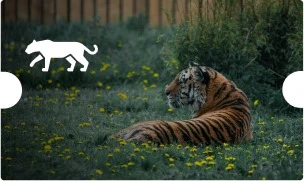Flora
Ranthambore Tiger Reserve falls under the dry and deciduous forest category. It features a combination of dry tropical forests, lakes, streams, rocky terrain, and grassy meadows. Over 300 tree species, 40 shrubs, and 20 grass species are recorded here. The most dominant tree species is Dhok (Anogeissus pendula), thriving in both the Aravalli and Vindhyan Mountain ranges, and serves as fodder for herbivores. Bird life is supported by fruit-bearing trees like Banyan (Ficus bengalensis), Pipal (Ficus religiosa), Neem (Azadirachta indica), Mango (Mangifera indica), Gular (Ficus glomerata), Tamarind (Tamarindus indica), Jamun (Syzygium cumini), Ber (Zizyphus mauritiana), and Bor (Zizyphus nummularia). Other main trees include Khair (Acacia catechu), Dhak (Butea monosperma), Reonj (Acacia leucophloea), Tendu (Diospyros melanoxylon), Salar (Boswellia serrata), Babul (Acacia nilotica), Gum (Sterculia urens), Gurjan (Lannea coromandelica), Khajur (Phoenix sylvestris), and Kakera (Flacourtia indica).
Fauna
Ranthambore is the perfect habitat for close encounters with tigers, the apex predator here. Tigers are frequently sighted due to their diurnal and nocturnal behavior, meaning more daytime movement and sightings for visitors. The park is home to over 40 mammal species, including some very elusive, rare, and lesser-known mammals. Among the mammals, seven cat species recorded here are Leopard, Leopard Cat, Desert Cat, Caracal, Fishing Cat, Jungle Cat, and Rusty Spotted Cat, which is a record for having eight cat species in one reserve. Among canids, Golden Jackal, Indian Fox, White Footed Fox, and the rare Indian Grey Wolf are recorded. Other mammals include Striped Hyena, Sloth Bear, Indian Ratel, Palm Civet, Ruddy Mongoose, Rufous-tailed Hare, Indian Boar, Indian Pangolin, Rhesus Macaque, Indian Hedgehog, and Porcupine. Two species of deer, Spotted Deer and Sambar Deer, and two species of antelopes, the Indian Gazelle and the Bluebull (Nilgai), form the major group of herbivores here.
Over 330 species of birds (resident and migratory) are recorded, making it a paradise for bird watchers. Painted Spurfowl, Sarus Crane, Bronzed Winged Jacana, Sandpiper, Nightjar, Great Horned Owl, Dusky Eagle Owl, Painted Sandgrouse, Crested Serpent Eagle, King Vulture, Pitta, and Sirkeer Malkoha are some of the species that can be seen during safari time. The park is rich in herpetofauna, recording over 24 snake species and 12 lizard species. Forty-five species of butterflies and 50 species of spiders roam freely near the host plants. With such a huge list of species, you are bound to see not just the tiger but many other forest species as well. ecosystem.












